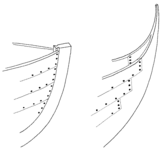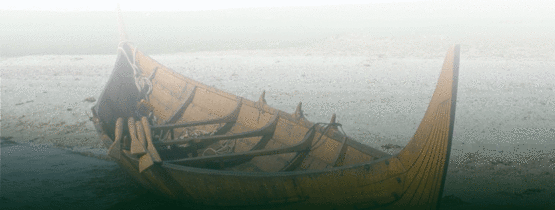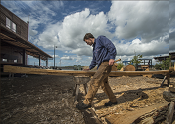Stem and keel

Explore the boat’s hull. Click on the grey areas to read more about the hull’s construction.

The boat's backbone
While the Middle Ages would see a number of major advances in maritime technology, at the time the Gislinge Boat was built in 1130, Scandinavian boatbuilding was still very much rooted in the Viking Age tradition. The most iconic element of Viking Age ships is probably the stems: the image of the streamlined hull, tapering off into narrow and elegant fore and after stems seems to underpin the speed and sailing capabilities of these ships, which made the Vikings the rulers of the seas in the centuries before.
Stepped-stems – such as those on the Gislinge Boat – are also where we see the clearest expression of Viking Age boatbuilding aesthetic. Made from a single piece of timber, the stems are carved in such a way as to create the illusion that the strakes all run seamlessly into the stem-top. This practice is what creates the sleek lines that we typically associate with Viking ships and its presence on a humble working boat like the Gislinge Boat, underlines how central an element of the boatbuilding tradition this was. Together with the t-shaped keel, the stems form the backbone of the boat and are the first elements that are produced when building a clinker-built boat.
Producing the keel and stems for the Gislinge Boat
The stems and keel for the Gislinge Boat are made of oak from Vallø Forest. The first step involved cleaving the oak and the initial cleave into halves went like clockwork. Upon closer inspection though, it transpired that the centre of the oak, the pith, had the early onset of some kind of fungus. Asger sent a number of samples to Hussvamp Laboratoriet for analysis and the problem was identified as Ox Tongue fungus (Fistulina hepatica). It had attacked the very centre of the oak but the samples taken confirmed that it hadn't extended further outwards. After much careful deliberation, it was decided that the damage was localised in such a small area that the boatbuilders could continue with the production of the stems, using wood from the unaffected area.
To make the stems, the oak was cleaved further into smaller sections and then the axe came into play as the principal tool used. The characteristic curve of the stems began to take shape and you started to get a sense of the eventual proportions of the finished element.
The outer shape of the stem was chopped out and the characteristic 'steps' cut into the backside. The lines along the sides of the stem - where the planks 'merge' into the stem - were marked out and the initial carving was done with a chisel. The stem was then hollowed out to the correct thickness, varying from 5cm at the stem-top to just 1cm at the join where the boards run into the stem.
The t-shaped keel
The 5.6m long keel is t-shaped and forms the spine of the boat. The keel was made from an oak trunk, which was gradually cut down to size: first it was roughly cut into a square profile and from there, the more detailed work in shaping the keel begins. Again, an axe was used as the primary tool, although the boatbuilders also use chisels when marking specific depths for the cuts and for the finer shaping of the curved ‘wings’ that form the keel’s outer edges. The keel was finished some time before the stems, so it was given liberal coatings of linseed oil and stored in the shade to prevent the oak from cracking.
The keel and stems were joined using scarf joints which are fastened with three iron rivets each. Tarred wool was placed between the opposing faces of the scarf as caulking. This helps to make the joint watertight.



The project in pictures - take a look at the Gislinge-gallery!

What is an open source project?
Read about our approach to Project Gislinge Boat here...

From wreck to reality
Learn more about the research behind the reconstruction...

Start from the beginning - Read all about the original find here!